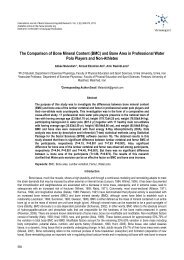Improved DAG SVM: A New Method for Multi-Class SVM Classification
Improved DAG SVM: A New Method for Multi-Class SVM Classification
Improved DAG SVM: A New Method for Multi-Class SVM Classification
Create successful ePaper yourself
Turn your PDF publications into a flip-book with our unique Google optimized e-Paper software.
Int'l Conf. Artificial Intelligence | ICAI'09 | 549<br />
Considering the noise with slack variables �� and error<br />
�<br />
penalty term ��� ���� �� , the optimal hyperplane can be<br />
found by solving the following quadratic optimization<br />
problem:<br />
����� �<br />
� ����� �<br />
������� ���<br />
��� ���������� ���� ���� ����� (3)<br />
2.2 <strong>Multi</strong>-class <strong>SVM</strong><br />
<strong>SVM</strong> <strong>for</strong>mulation has been originally developed <strong>for</strong><br />
binary classification problems and finding the direct<br />
<strong>for</strong>mulation <strong>for</strong> multi-class case is not easy and still an ongoing<br />
research issue. In two ways we can have a multi-class<br />
<strong>SVM</strong> classifier; one is to directly consider all data in one<br />
optimization <strong>for</strong>mulation, and the other is to decompose<br />
multi-class problem to several binary problems. The second<br />
solution is a better idea and has been considered more than<br />
the first approach [13-17] because binary classifiers are<br />
easier to implement and moreover some powerful<br />
algorithms such as Support Vector Machine (<strong>SVM</strong>) are<br />
inherently binary [18]. Two major decomposition<br />
implementations are: “one-against-all” and “one-against<br />
one”.<br />
The one-against-all [1] method constructs n <strong>SVM</strong>s<br />
where n is the number of classes. The i th <strong>SVM</strong> is trained to<br />
separate the i th class from remaining classes. The oneagainst-one<br />
[14] (pairwise <strong>SVM</strong>s) instead, constructs n(n-<br />
1)/2 decision functions <strong>for</strong> all the combinations of class<br />
pairs. In determination of a decision function <strong>for</strong> a class<br />
pair, we use the training data <strong>for</strong> the corresponding two<br />
classes. Thus, in each training session, the number of the<br />
training data is reduced considerably compared to oneagainst-all<br />
support vector machines, which use all the<br />
training data. Experimental results in [19] indicate that the<br />
one-against-one is more suitable <strong>for</strong> practical use. We<br />
continue our discussion with focus on the pairwise <strong>SVM</strong>s<br />
method in next section (more details appeared in [20]).<br />
3 <strong>DAG</strong> <strong>SVM</strong><br />
A problem with both on-against-all and pairwise support<br />
vector machines is unclassifiable regions. In pairwise<br />
<strong>SVM</strong>s, let the decision function <strong>for</strong> class i against class j,<br />
with the maximal margin, be:<br />
� ����� �� �� � ���� �������������������������������������<br />
where � �� is the d-dimensional vector, ���� is a mapping<br />
function that maps � into the d-dimensional feature space,<br />
� ���is the bias term, and �� ����� ��� �����.<br />
The regions Ri are shown in Figure 1 with labels of class I,<br />
II, and III.<br />
� � ����� ����� � �� � � ���� � � �� � � ���������������������<br />
If � is in Ri, we classify � into class i. If � is not in<br />
� ��� � ���� � � ��, � is classified by voting. Namely, <strong>for</strong> the<br />
input vector �� � �����is calculated at follow:<br />
where<br />
�<br />
����� � � ������������ ��������������������������<br />
�������<br />
�������������� � ��<br />
������� ��<br />
��������������� � �� �������������������������<br />
and x is classified into class:<br />
��� ���<br />
���������� � ������������������������������������������<br />
If ����� �,� ���� ���� and� ���� � � � �������� � ��Thus,<br />
� is classified into �. But if any of � ���� is not ���, ���<br />
may be satisfied <strong>for</strong> plural is. In this case, � is<br />
unclassifiable. In the shaded region in Figure 1,<br />
� ���� ����� ����������� . There<strong>for</strong>e, this region is<br />
unclassifiable, although the unclassifiable region is much<br />
smaller than that <strong>for</strong> the one-against-all support vector<br />
machine.<br />
Figure 1: Unclassifiable regions by the pairwise <strong>for</strong>mulation.<br />
In pairwise <strong>SVM</strong>s, classification reduces the<br />
unclassifiable regions that occur <strong>for</strong> one-against-all<br />
support vector machines but it still exists. To resolve this<br />
problem, Vapnik [2] proposed to use continuous decision<br />
functions. Namely, we classify a datum into the class with<br />
maximum value of the decision functions. Inoue and Abe<br />
[21] proposed fuzzy support vector machines, in which<br />
membership functions are defined using the decision<br />
functions. Another popular solution is <strong>DAG</strong> <strong>SVM</strong> that uses<br />
a decision tree in the testing stage. Training of a <strong>DAG</strong> is<br />
the same as conventional pairwise <strong>SVM</strong>s. <strong>Class</strong>ification by<br />
<strong>DAG</strong>s is faster than by conventional pairwise <strong>SVM</strong>s or<br />
pairwise fuzzy <strong>SVM</strong>s. Figure 2 shows the decision tree <strong>for</strong><br />
the three classes shown in Figure 1. In the figure, � shows<br />
that x does not belong to class i. As the top-level<br />
classification, we can choose any pair of classes. And<br />
except <strong>for</strong> the leaf node if � ����� ��, we consider that x<br />
does not belong to class j, and if � ����� �� not class i.<br />
Thus, if � ����� ��, x does not belong to class II.<br />
There<strong>for</strong>e, it belongs to either class I or class III, and the<br />
next classification pair is classes I and III.








